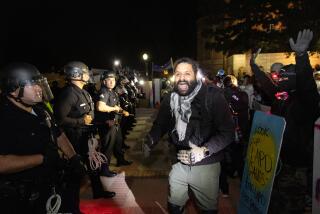Students Display War Horrors of Nanking
- Share via
Carol Liu knew from her family that Japan’s occupation of Manchuria was brutal. But her family’s stories about life in wartime China only hinted at the horrors.
Earlier this year, the 17-year-old Los Angeles high school student read a book about atrocities in Nanking, now known as Nanjing. The pages revealed in vivid written and photographic detail the massacre of several hundred thousand Chinese soldiers and civilians by the Japanese army.
“It was shocking to me,” said Liu, whose family lived in Shanghai during World War II and moved here in 1980. “I felt a lot of people had never heard of what happened at Nanjing, and I thought that they should.”
Liu and Misun Hwang, a classmate at Marymount High School across from UCLA, became determined to spark a local dialogue on the killings. Their efforts--accomplished completely on their own time and not for school credit--have resulted in a photographic exhibition at UCLA called “Forgotten War Crimes: World War II in Asia.”
The show, which ends Sunday at UCLA’s Kerckhoff Hall, may mark the first time high school students have been responsible for the installation of an exhibit in the popular campus student center. In fact, when the two students first presented the idea to UCLA Cultural Affairs Commissioner Marselle Washington, he didn’t realize they were still in high school.
“I figured it out when Carol kept referring to me as ‘Mr. Washington,’ ” said Washington, who is an undergraduate student at UCLA.
The genesis for the exhibit was Liu’s reading of the 1997 bestseller “The Rape of Nanking: The Forgotten Holocaust of World War II.” The book by Northern California author Iris Chang was generally praised by historians in the United States and ignited some controversy in Japan, where ultranationalists asserted the massacre never occured.
Liu was utterly transfixed by Chang’s account of the Japanese Imperial Army’s action in December 1937. She read that Chinese were used for bayonet practice, while others were burned or buried alive in mass graves.
After sharing the book with classmate Hwang, the two tried a number of sources in the book’s bibliography. Eventually, they got in touch with an organization called the Assn. for Preserving the History of World War II in Asia, which promised to loan the students the material for an exhibit if they could secure a site.
The two contacted several local museums and colleges but were unable to locate space. “A couple times we thought, ‘Oh, this is never going to happen,’ ” said Liu who put together a discussion board at https://www.sites.netscape.net/sathorg/homepage.
Then, they tried UCLA. “I guess the reason I took this was because I’d never heard of it,” said Washington, who had worked in the cultural affairs office for four years. “There’s no reason every student here shouldn’t know about this.”
The exhibit features 29 double-side panels of text and period photographs and is not for the faint of heart. Before entering the second-floor art gallery space, visitors see a sign that advises viewer discretion because of the exhibit’s graphic content, which includes dismembered bodies.
In addition to the graphic materials about the Nanjing massacre, the exhibit also provides equally compelling information about the Japanese Imperial Army’s use of live human experiments and “comfort women.” The Japanese Army’s notorious “Unit 731” performed surgeries without anesthesia on Chinese civilians and Allied POWs. It also enslaved an estimated 200,000 women, primarily from Korea, who were routinely raped by soldiers.
“I never knew the extent of this--the comfort women, the persecutions,” Stephen Kwok, 28, a computer analyst at UCLA, said after viewing the exhibit.
Kwok’s family fled China for Hong Kong during World War II. He remembers his grandmother talking about the war, but never anything as intense as the exhibit.
“Maybe this is more than my grandmother knew. But I don’t know, since she didn’t really talk about it much.”
Since the exhibit opened on Nov. 20, “I’ve never had so many phone calls,” said Washington.
There is an urgency about their exhibit, say Liu and Hwang, since many of the survivors of World War II atrocities in Asia are dying of old age. Young people need to learn about the past to avoid the same tragedies from happening in the future, the two students add.
“Our main purpose is to educate people about the atrocities,” said Hwang, who eventually wants to become a doctor. “Just by ourselves we can’t do much. But we’re hoping this exhibit will help spread the word.”
More to Read
Sign up for Essential California
The most important California stories and recommendations in your inbox every morning.
You may occasionally receive promotional content from the Los Angeles Times.










